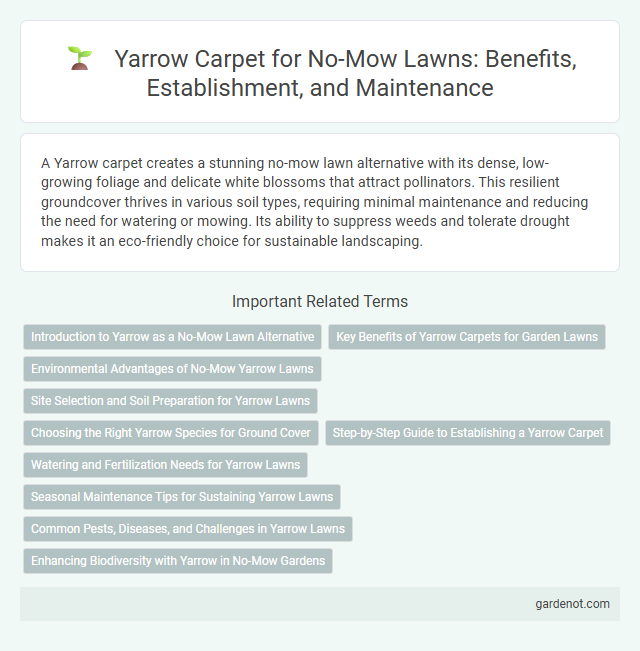A Yarrow carpet creates a stunning no-mow lawn alternative with its dense, low-growing foliage and delicate white blossoms that attract pollinators. This resilient groundcover thrives in various soil types, requiring minimal maintenance and reducing the need for watering or mowing. Its ability to suppress weeds and tolerate drought makes it an eco-friendly choice for sustainable landscaping.
Introduction to Yarrow as a No-Mow Lawn Alternative
Yarrow carpet is an excellent no-mow lawn alternative known for its low maintenance and drought tolerance. This perennial ground cover features feathery, aromatic foliage and clusters of small white or yellow flowers, creating a dense, attractive carpet that suppresses weeds naturally. Its ability to thrive in poor soil conditions and resist foot traffic makes yarrow carpet a sustainable, eco-friendly choice for homeowners seeking a green lawn without regular mowing.
Key Benefits of Yarrow Carpets for Garden Lawns
Yarrow carpets provide excellent ground cover for garden lawns, enhancing soil health by reducing erosion and improving moisture retention with their dense, low-growing foliage. Their drought tolerance and ability to thrive in poor soil conditions make them ideal for sustainable, low-maintenance no-mow lawns that require minimal watering. Yarrow also attracts beneficial pollinators such as bees and butterflies, promoting biodiversity and a healthy garden ecosystem.
Environmental Advantages of No-Mow Yarrow Lawns
No-mow Yarrow lawns significantly reduce water consumption due to their deep root systems that enhance soil moisture retention. These lawns provide essential habitat and nectar sources for pollinators, promoting biodiversity and supporting local ecosystems. The absence of mowing decreases carbon emissions and fossil fuel use, contributing to a lower environmental footprint.
Site Selection and Soil Preparation for Yarrow Lawns
Yarrow lawns thrive in well-drained soil with a neutral to slightly alkaline pH, making site selection critical for successful growth. Preparing the soil involves removing existing grass and weeds, loosening the topsoil, and incorporating organic compost to improve aeration and nutrient content. Choosing a sunny location with moderate foot traffic ensures the durable and drought-tolerant yarrow carpet establishes effectively over time.
Choosing the Right Yarrow Species for Ground Cover
Selecting the right yarrow species is crucial for creating an effective no-mow lawn ground cover, with Achillea millefolium being a popular choice due to its adaptability and drought tolerance. For warmer climates, Achillea filipendulina offers vibrant yellow blooms and robust growth, enhancing both aesthetics and soil stability. Consider the specific growth habits, bloom colors, and regional climate compatibility to ensure the yarrow species supports sustainable, low-maintenance landscaping.
Step-by-Step Guide to Establishing a Yarrow Carpet
To establish a Yarrow carpet, start by selecting a sunny, well-drained area and prepare the soil by loosening it to enhance root penetration and water absorption. Sow Yarrow seeds evenly across the prepared soil, then lightly rake to ensure good seed-to-soil contact and water gently to keep the soil consistently moist during germination. Maintain the young plants by watering as needed and trimming periodically to promote dense growth and prevent weeds from taking over the no-mow lawn area.
Watering and Fertilization Needs for Yarrow Lawns
Yarrow lawns require minimal watering, thriving primarily on natural rainfall due to their drought-tolerant nature. Fertilization for yarrow carpets is rarely necessary, as excessive nutrients can lead to unwanted leggy growth and reduced blooming. Maintaining well-drained soil ensures optimal health and dense, vibrant coverage without the need for frequent supplemental care.
Seasonal Maintenance Tips for Sustaining Yarrow Lawns
Yarrow lawns thrive with minimal mowing but require seasonal maintenance to sustain dense growth and vibrant blooms. During spring, trim dead foliage to promote fresh shoots, while light pruning after flowering in summer encourages prolonged blooming. Applying a balanced fertilizer in early fall supports root development, ensuring a healthy, resilient Yarrow carpet throughout the year.
Common Pests, Diseases, and Challenges in Yarrow Lawns
Yarrow lawns often face challenges from aphids, spider mites, and leafhoppers, which can cause discoloration and stunted growth. Powdery mildew and root rot are common diseases affecting yarrow, especially in poorly-drained soils or humid conditions. Maintaining proper air circulation, avoiding overwatering, and monitoring pest populations are essential for healthy no-mow yarrow carpets.
Enhancing Biodiversity with Yarrow in No-Mow Gardens
Yarrow (Achillea millefolium) significantly enhances biodiversity in no-mow gardens by providing essential nectar and pollen sources for pollinators such as bees and butterflies. Its dense, low-growing carpet suppresses weed growth while creating habitat for beneficial insects and soil microorganisms. This resilient perennial promotes a balanced ecosystem, supporting wildlife and improving soil health in sustainable lawn alternatives.
Yarrow carpet Infographic

 gardenot.com
gardenot.com